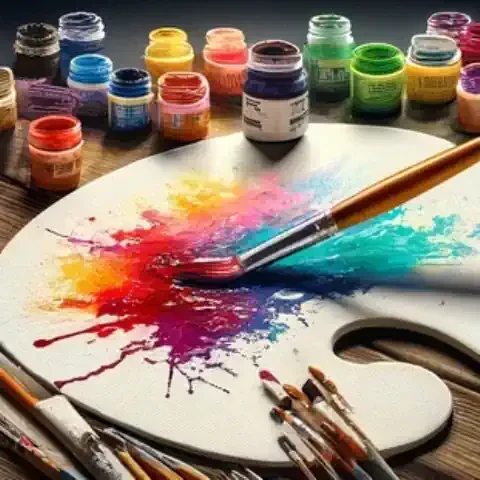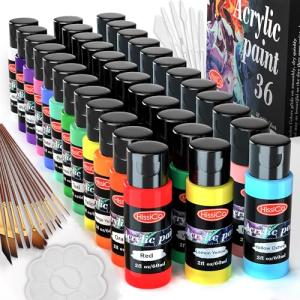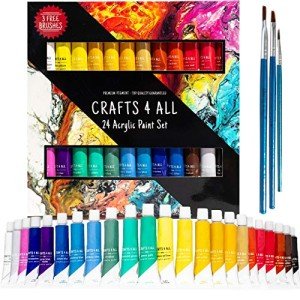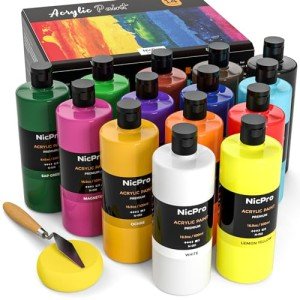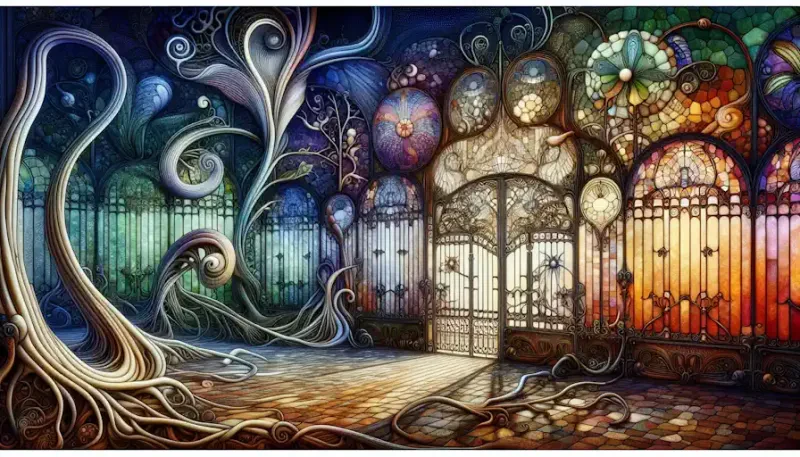Introduction
Acrylic painting stands as a beacon of accessibility and versatility in the vast world of artistic expression. With its quick drying time, vibrant colors, and adaptable nature, acrylics have earned a place in the hearts of artists ranging from beginners to seasoned professionals. However, the journey towards creating captivating acrylic artworks extends beyond mere talent or inspiration—it hinges upon the meticulous assembly of the right tools and materials.
In this article, we embark on a journey to demystify the process of building the perfect acrylic painting kit. Whether you're a novice seeking to dip your brush into the realm of acrylics or a seasoned artist looking to refine your toolkit, the significance of selecting the appropriate instruments cannot be overstated. From brushes to palettes, canvases to mediums, each component plays a pivotal role in shaping the outcome of your artistic endeavors.
Our aim is simple yet profound: to empower you, the reader, with the knowledge and guidance necessary to curate a collection of materials that aligns seamlessly with your artistic vision. By delving into the nuances of acrylic painting essentials, we endeavor to equip you with the tools needed to unleash your creativity and embark on a journey of boundless artistic exploration. Join us as we unravel the intricacies of assembling your perfect acrylic painting kit, paving the way for a world of artistic possibilities.
Understanding Acrylic Paints
Acrylic paints, revered for their versatility and vibrant hues, are water-based paints composed of pigment suspended in an acrylic polymer emulsion. This unique composition offers a myriad of benefits, including fast drying times, durability, and the ability to be thinned with water or mediums for various techniques.
Artist Grade vs. Student Grade
Acrylic paints are available in two main grades: artist grade and student grade. Artist grade paints typically boast higher pigment concentrations and superior lightfastness, resulting in richer, more vibrant colors and longer-lasting artworks. On the other hand, student grade paints are more budget-friendly and are often formulated with less pigment, resulting in colors that may appear duller and have reduced permanence.
Factors to Consider When Choosing Acrylic Paints
When selecting acrylic paints for your artistic endeavors, several key factors should be taken into account:
Pigment Quality: The quality of the pigment directly influences the intensity and permanence of the colors. Look for paints labeled with lightfastness ratings, indicating their resistance to fading over time.
Color Range: Acrylic paints come in an extensive array of colors, including primary, secondary, and tertiary hues, as well as specialty colors like metallics and fluorescents. Consider the color range offered by a brand and how it aligns with your artistic vision.
Opacity and Transparency: Acrylic paints vary in opacity, ranging from opaque to translucent. Understanding the opacity of a paint color is crucial for achieving desired layering effects and depth in your artwork.
Consistency: Acrylic paints can be found in various consistencies, including heavy body, fluid, and soft body. The consistency of the paint affects its texture and application, with heavy body paints retaining brushstrokes and fluid paints flowing more freely.
Drying Time: Acrylic paints dry quickly, allowing for rapid layering and experimentation. However, some brands offer extended drying times or retarders to provide more working time for blending and manipulation.
By carefully considering these factors, artists can make informed decisions when choosing acrylic paints that best suit their artistic style, preferences, and budget. Whether opting for artist grade paints prized for their quality or student grade paints valued for their affordability, the right selection of acrylic paints sets the foundation for successful and fulfilling creative endeavors.
Essential Tools for Acrylic Painting
Acrylic painting is as much about technique as it is about the tools used to apply the paint. Here are some essential tools every acrylic painter should have in their arsenal:
Paintbrushes
Paintbrushes are the primary tools for applying acrylic paint onto a surface. Understanding the different types of brushes and their uses is essential for achieving various textures and effects in your artwork. Some common types of brushes include:
Round brushes: Ideal for sketching, detailing, and creating thin lines.
Flat brushes: Perfect for covering large areas, creating bold strokes, and applying washes.
Filbert brushes: Characterized by their rounded tip and flat ferrule, filbert brushes are versatile tools suitable for blending, softening edges, and creating rounded shapes.
Having a wide variety of brushes in different shapes, sizes, and bristle types allows artists to experiment with various techniques and achieve diverse effects in their paintings.
Palette
A palette serves as a mixing surface for blending and diluting acrylic paints. There are several types of palettes available, each offering unique advantages:
Traditional palettes: Made from materials such as wood, plastic, or glass, traditional palettes are durable and provide a stable surface for mixing paints.
Disposable palettes: Convenient for easy cleanup, disposable palettes are typically made from tear-off sheets of wax-coated paper or plastic.
Stay-wet palettes: Designed with a special membrane or sponge to keep acrylic paints moist and workable for extended periods, stay-wet palettes are favored by artists who require longer painting sessions or wet-on-wet techniques.
Choosing the right palette depends on factors such as personal preference, painting style, and workflow preferences.
Surface
The surface on which you paint plays a significant role in the outcome of your artwork. While canvases are commonly used for acrylic painting, other surfaces such as wood panels offer unique textures and characteristics. Factors to consider when selecting a painting surface include:
Texture: The texture of the surface affects the appearance and feel of the finished painting. Smooth surfaces are suitable for detailed work, while textured surfaces add depth and interest to the artwork.
Size: Choose a surface size that accommodates the scale of your painting and fits comfortably within your workspace.
Priming: Some surfaces require priming with gesso or acrylic primer to create a suitable painting surface. Primed surfaces ensure proper adhesion and longevity of the paint layers.
Experimenting with different surfaces allows artists to explore various textures and effects in their acrylic paintings.
Easel
Using an easel provides numerous benefits for acrylic painters, including improved posture, better control over brushstrokes, and the ability to work on larger canvases. There are several types of easels available to suit different preferences and working environments:
Tabletop easels: Compact and portable, tabletop easels are ideal for smaller workspaces or painting on smaller surfaces.
Standing easels: Floor-standing easels offer stability and adjustability, allowing artists to work comfortably whether sitting or standing.
Adjustable easels: Easels with adjustable features such as height, angle, and tilt provide flexibility and customization options to accommodate various painting techniques and preferences.
Investing in a quality easel enhances the painting experience and contributes to the overall success of acrylic artworks.
Additional Materials and Accessories
In addition to paintbrushes, palettes, surfaces, and easels, there are several other materials and accessories that can enhance the acrylic painting process and expand the artist's creative possibilities:
Mediums and Additives
Acrylic mediums are substances that can be mixed with acrylic paint to alter its properties, consistency, and drying time. Some common acrylic mediums include:
Gel medium: Adds body and texture to acrylic paint, allowing for impasto techniques and creating three-dimensional effects.
Modeling paste: A thick, sculptural medium used to build texture and create raised surfaces in acrylic paintings.
Matte medium: Adds transparency and extends drying time while maintaining a matte finish.
Flow improver: Increases the flow and workability of acrylic paint, making it easier to blend and apply smoothly.
These mediums can be combined with acrylic paint to achieve a wide range of effects, from glossy finishes to textured surfaces.
Palette Knives
Palette knives are versatile tools used for applying, mixing, and manipulating acrylic paint on the canvas. Some common uses of palette knives in acrylic painting include:
Applying thick layers of paint: Palette knives are ideal for creating impasto effects and building up texture on the canvas.
Mixing colors: Palette knives can be used to mix paint directly on the palette, allowing for precise color blending and customization.
Creating texture: By dragging, scraping, or stippling paint with the edge or tip of the palette knife, artists can achieve various textures and surface effects.
Palette knives come in a variety of shapes and sizes, each serving a specific purpose. Flat, angled, and trowel-shaped knives are among the most common, with different blade shapes offering different levels of control and versatility.
Solvents and Cleaning Supplies
Keeping brushes and palettes clean is essential for maintaining their performance and prolonging their lifespan. Acrylic painters may use solvents and cleaning supplies such as:
Water: Acrylic paints are water-soluble, making water an effective and safe solvent for cleaning brushes and palettes.
Mild soap: A gentle soap solution can be used to remove stubborn paint residues from brushes and palettes without damaging the bristles or surfaces.
Acrylic brush cleaner: Commercial brush cleaners formulated specifically for acrylic paints can help dissolve dried paint and restore brushes to their original condition.
Using clean brushes and palettes ensures accurate color mixing and prevents contamination of paint layers, resulting in cleaner, more professional-looking artwork.
Other Accessories
Masking tape: Used for creating clean edges and masking off areas of the canvas during painting.
Sponges: Ideal for applying paint in a stippled or textured manner, as well as for blending colors and creating soft transitions.
Spray bottles: Useful for keeping acrylic paints moist on the palette and for creating watercolor-like effects by misting the canvas with water.
These accessories offer additional versatility and control in the acrylic painting process, allowing artists to experiment with different techniques and achieve unique visual effects.
Building Your Perfect Art Kit
Creating the ideal acrylic painting kit involves a thoughtful process of assessment, planning, and adaptation to ensure that it meets your individual needs and preferences. Here are some essential steps to guide you in building your perfect art kit:
Assessing Your Needs and Preferences
Begin by evaluating your artistic goals, preferred painting techniques, and the subjects you wish to depict. Consider factors such as:
Style: Do you prefer realistic or abstract painting? Are you drawn to bold, expressive strokes or delicate, intricate details?
Subject Matter: Will you primarily paint landscapes, portraits, still lifes, or abstract compositions?
Workspace: What are the limitations and opportunities of your painting space in terms of size, lighting, and ventilation?
Understanding your unique artistic identity and requirements will help you select materials and tools that align with your creative vision.
Setting a Budget
Determine a budget that reflects your financial resources and commitment to your artistic practice. Consider allocating funds for essential items such as paints, brushes, and surfaces, as well as optional accessories that enhance your painting experience.
Balancing quality with affordability is key when budgeting for art supplies. While investing in high-quality paints and brushes may incur higher initial costs, their superior performance and longevity can lead to greater satisfaction and value over time.
Exploring Optional Accessories
While essential materials like paints and brushes form the core of your art kit, optional accessories can elevate your painting experience and facilitate experimentation. Some optional accessories to consider include:
Palette knives: Expand your painting techniques and create unique textures with palette knives.
Texture tools: Experiment with unconventional tools such as sponges, combs, and stencils to add depth and interest to your artworks.
Storage solutions: Organize and protect your art supplies with storage containers, brush holders, and portfolio cases.
Assess the relevance and utility of optional accessories based on your artistic interests and workflow preferences.
Researching and Comparing Brands and Products
Take time to research and compare different brands and products before making purchasing decisions. Consider factors such as:
Quality: Evaluate the reputation and reviews of art supply brands in terms of product quality, consistency, and durability.
Variety: Look for brands that offer a diverse range of colors, mediums, and tools to support your creative expression.
Compatibility: Ensure compatibility between different materials and mediums to achieve desired results in your artworks.
Gathering information and seeking recommendations from fellow artists can help you make informed choices and avoid costly mistakes.
Making Adjustments and Additions Over Time
As you continue to develop your skills and explore new artistic techniques, your needs and preferences may evolve. Remain open to making adjustments and additions to your art kit over time to accommodate your changing creative pursuits.
Regularly assess the performance and condition of your art supplies, replacing worn-out brushes, replenishing depleted paints, and exploring new mediums and tools as needed. Embrace the journey of artistic growth and adaptation, refining your art kit to support your evolving artistic vision.
By following these steps and staying attuned to your artistic journey, you can build a personalized and effective art kit that empowers you to express yourself freely and confidently through acrylic painting.
Acrylic Painting Essentials
As we conclude our exploration into the world of acrylic painting essentials, it's essential to reflect on the key insights gained and the path forward for aspiring artists:
Recap of Key Points
Throughout this article, we've delved into the fundamental aspects of acrylic painting, from understanding the characteristics of acrylic paints to assembling the essential tools and accessories for a successful painting experience. We've explored the importance of selecting high-quality materials, considering personal preferences, and investing in tools that support your artistic vision.
Encouragement for Personalization
I encourage you, the reader, to embark on your own journey of experimentation and personalization as you build your acrylic painting kit. Embrace the opportunity to explore different techniques, mediums, and surfaces, allowing your creativity to flourish and evolve with each brushstroke. Your unique artistic voice deserves to be heard, and your art kit should reflect your individuality and aspirations.
Importance of Practice and Exploration
Remember, mastery in acrylic painting is not achieved overnight. It requires dedication, patience, and a willingness to push boundaries through continuous practice and exploration. Embrace challenges as opportunities for growth, and celebrate each painting as a step forward in your artistic journey. With persistence and passion, you'll uncover new techniques, refine your skills, and unlock the full potential of acrylic painting.
Invitation to Stay Tuned
I invite you to stay tuned for more tips, tutorials, and inspiration on acrylic painting techniques and projects. Whether you're seeking guidance on color mixing, texture creation, or composition, there's always something new to discover and learn. Let's continue this artistic exploration together, sharing insights, celebrating achievements, and inspiring one another to reach new heights in our creative pursuits.
In closing, may your acrylic painting journey be filled with joy, discovery, and boundless creativity. Embrace the process, trust your instincts, and let your imagination soar across the canvas. Happy painting!
